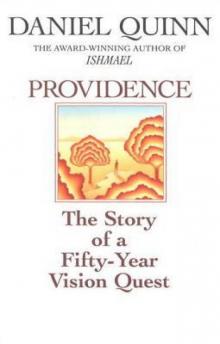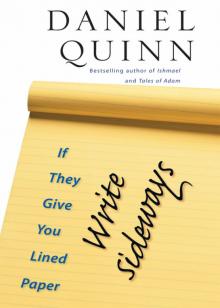- Home
- Daniel Quinn
If They Give You Lined Paper, Write Sideways Page 11
If They Give You Lined Paper, Write Sideways Read online
Page 11
Daniel. And what exactly is there to protest?
Elaine. The World Trade Organization is pretty popular.
Daniel. Do you think these questioners would consider protesting the World Trade Organization to be “enough”?
Elaine. Enough to do what?
Daniel. Well, since they’re writing to me, what do you think they mean by “enough”?
Elaine. I guess I’d have to say … saving the human future.
Daniel. I’d agree.
Elaine. And protesting the WTO isn’t going to do that.
Daniel. So how do you protest the things that put the human future in doubt? Who do you protest to?
Elaine. I don’t know. The people around you. People in general.
Daniel. How do you organize a protest like that?
Elaine. I have no idea.
Daniel. I know of one recent instance in which protest was effective — the protest against the war in Vietnam. But what made that effective?
Elaine. I’m afraid I don’t know that period very well.
Daniel. At the foundation of the movement to end the war were “teach-ins” designed to change the way people thought about the war — as opposed to the way the government wanted them to think about it. The heart of the movement was changing minds.
Elaine. And also the target was very well defined. They knew who to protest to and about what in a very exact way.
Daniel. That’s right. What are some other forms of action?
Elaine. There’s the Greenpeace style of action. And Earth First.
Daniel. Yes. Fighting the existing reality … One of the things that people often complain about changing minds is that it takes too long. Greenpeace has been at its work for thirty years, and they’ve certainly achieved some good results, but all the things they work against are still going on. But no one complains that what they’re doing “takes too long.”
Elaine. Because it’s perceived to be action. Action doesn’t have to work.
Daniel. That’s a very astute observation — the observation of a Martian anthropologist. Expand on that.
Elaine. Well … the War on Drugs doesn’t work — everybody knows that. We’ve spent billions on it, maybe trillions, but that’s okay. It’s action.
Daniel. In a speech I made to the Minnesota Social Investment Forum in 1993 I proposed passing legislation that would temporarily suspend present drug laws, say for three years. If we didn’t like the results, we wouldn’t have to do anything. The drug laws would automatically go back into effect.
Elaine. That makes sense.
Daniel. What do you think would be the result of that action?
Elaine. It wouldn’t end drug use.
Daniel. Neither has the War on Drugs.
Elaine. True … Let’s see … The illegal drug trade would end almost immediately, as soon as the legitimate drug companies were ready to take it over … You’d have to have age limits, of course.
Daniel. So some illegal trade would continue, just as it does with alcohol and tobacco.
Elaine. It probably wouldn’t be as organized as it is now. I mean, kids manage to get cigarettes and booze pretty easily if they want them.
Daniel. In any case, we’d have three years to study the results. If things got worse, we’d just let the drug laws automatically go back into effect. Or if things seemed to be getting better, we could extend the suspension for another three years and see what happens.
Elaine. It makes too much sense ever to be adopted.
Daniel. On the other hand, Prohibition — the War on Alcohol — was eventually abandoned.
Elaine. True … But drinking was always more … mainstream. I mean, drinking itself wasn’t criminalized, was it?
Daniel. No, I never heard of anyone doing hard time for having a drink. It was just illegal to manufacture, sell, transport, or import the stuff.
Elaine. Uh-huh.
Daniel. Despite its long history of failure, this belief in the effectiveness of action runs deep in our culture. Enacting the Eighteenth Amendment, the amendment that instituted Prohibition, was action, and it was cheered by tens of millions. The fact that it not only failed to produce a sober nation but gave drinking a new cachet and encouraged the rise of a vast new criminal enterprise didn’t dampen anyone’s enthusiasm for action. After World War Two, Communism came to be perceived as the greatest threat ever faced by this nation. This called for action. The public loved the witch hunt instigated by the House Un-American Activities Committee, especially when it produced a Hollywood blacklist of famous actors, directors, and writers whose films were in fact no more subversive of “American” values than any others.
Elaine. I’ve heard of it, though it was before my time, obviously.
Daniel. But of course that was very minor action compared with the trillions of dollars the government spent to thwart the spread of Communism and hopefully bring down the Soviet Union. Forty-odd years of action, action, action. Then, suddenly, the Soviet Union simply dissolved — not because of any action undertaken by our government, but because the minds of the Soviet people had changed. They were fed up with the lives their government had given them. The greatest Communist experiment of all time had failed, and the spread of Communism ceased to seem like much of a threat — again, through no action taken by our government.
Elaine. Then came the War on Drugs.
Daniel. More trillions spent, and no sign of victory anywhere. But plenty of action.
Elaine. I’d say that some environmental legislation produced good results.
Daniel. Yet we’ve reelected a president who’s made it clear that he doesn’t give a damn about protecting the environment. What’s this mean?
Elaine. That the voters who put him in office don’t give a damn, either.
Daniel. When will they start giving a damn?
Elaine. When they starting thinking a new way.
Daniel. So it always comes back to that. It doesn’t do much good to have the laws in place unless we elect a chief executive who wants to execute them.
Elaine. True.
Daniel. Here’s another way to look at this. Action proceeds automatically from vision. I mean that if a certain vision is in place, you don’t have to “take action” to realize it. For example, if the American people didn’t want to drink alcohol, the Eighteenth Amendment wouldn’t have been needed, would it?
Elaine. No. They would just have stopped drinking. Then the manufacturers would’ve stopped making it and the importers would’ve stopped importing it.
Daniel. But in fact they didn’t want to stop drinking, so passing the Eighteenth Amendment was futile: It wasn’t supported by the prevalent vision. Similarly, they don’t want to stop using drugs like marijuana, cocaine, and heroin, so the War on Drugs is just as futile. This is certainly, at least in part, what Buckminster Fuller meant when he said, “You never change things by fighting the existing reality.” The existing reality hasn’t changed a particle since the war began. Except, that is, for the worse. Just speaking from personal experience, the only drugs I saw being used by kids in my school days were nicotine and booze.
Elaine. That’s certainly changed.
Daniel. By far the biggest action of the last three centuries has been the Industrial Revolution, and that was driven entirely by vision. I assume you know what that vision was.
Elaine. Yes. Again just reciting, people began to see that they could get ahead by inventing new things, developing new processes — or improving on old ones.
Daniel. No one had to “take action” to make it happen — no one had to pass laws requiring people to be inventive.
Elaine. It was in their own interest to be inventive.
Daniel. But you understand that the Industrial Revolution couldn’t have started during the Middle Ages.
Elaine. No, the vision wasn’t there. It only came into existence as a result of the Renaissance and the scientific revolution it ushered in.
Daniel [after a short break].
What do you know about hypnotism?
Elaine. Hypnotism? That’s quite a change of subject.
Daniel. Yes.
Elaine. What do I know about it …? Nothing more than is generally known.
Daniel. What would you say is generally known?
Elaine. Golly … I’d say that “known” is probably too strong a word. [Thinks about it for a while.] The impression you get from hypnotism in the movies is that it induces a trance state in which the subject is highly suggestible and can be given instructions that will be carried out after being brought out of hypnosis. Supposedly.
Daniel. Supposedly?
Elaine. I think there’s some doubt — among those qualified to have doubts — that hypnotism actually exists. The hypnotic state may just be something the subject unconsciously adopts to please the hypnotist.
Daniel. Yes, that’s a fair statement.
Elaine. It strikes me as being unprovable either way.
Daniel. That was true for a long time, but recent brain-imaging studies seem to suggest that there really is a hypnotic state that is quite distinct from the ordinary. I’ll have to back up and take a running start at this … When your eye encounters photons bouncing off an apple, they’re turned into a pattern that’s sent to the primary visual cortex. There, the general shape of the apple is recognized and sent on to a higher region of brain function where its color is identified. Then this pattern moves along to a still-higher region where it’s put together with other knowledge that enables you to recognize that this is an apple, not a strawberry. This bottom-to-top flow of data is what we think of as the ordinary process of perception.
Elaine. Uh-huh.
Daniel. But there is also a top-to-bottom flow of information that is equally powerful, and it’s a curious fact that the neural paths carrying information down to the bottom outnumber paths carrying information up to the top ten to one.
Elaine. That is strange.
Daniel. It’s a commonplace that to Western eyes all Orientals look alike — and vice versa. If you and a Korean are presented with two Oriental faces, the same photons will reach both of your eyes, but what you and the Korean will actually end up perceiving will be very different. You’ll very likely be struck by their similarities, while the Korean observer will be struck by their differences. For example, he’ll be able to tell you whether the two individuals are Korean, Chinese, or Japanese. The Korean will notice the characteristics that distinguish one face from the other, whereas he would probably fail to see the characteristics that distinguish one Caucasian face from another.
Elaine. I see what you’re saying. A lifetime of experience outweighs what the eyes are taking in.
Daniel. An exotic insect in a photograph might strike you as something repulsive, but it would strike an entomologist in an entirely different way.
Elaine. Uh-huh.
Daniel. In Nazi concentration camps the same images reached the eyes of the prisoners and the guards, but the guards, conditioned by decades of anti-Semitism, no longer saw humans when they looked at Jews, they saw vermin that deserved to be exterminated. In other words, the top level of perception overruled the bottom level, so that they were able to do their killing without feelings of guilt or remorse. The Stockholm syndrome is probably an example of the same effect.
Elaine. Remind me what that is.
Daniel. Hostages cease to see their captors as enemies and identify them as allies.
Elaine. Yeah.
Daniel. Faith healing represents another example. A famous case is that of one Helen Sullivan, who suffered from a cancer that had weakened her spine to such an extent that she spent most of her time in a wheelchair and could only walk with the support of a brace. In fact, she hadn’t been without the brace for four months when she attended a “Miracle Service” held by Kathryn Kuhlman, a practitioner of the “shotgun” technique of faith healing, which consists of announcing that someone in the audience is being cured of something — rather than inviting someone up to be cured.
Mrs. Sullivan, hearing that someone was “being” cured of cancer, was sure it was her. She hobbled from her wheelchair to the stage, tore off her brace, and ran back and forth across the stage several times, then returned to her wheelchair, waving her brace in the air. A few hours later, in the middle of the night, she woke up in terrible pain. X-rays revealed that a cancer-weakened vertebra had collapsed, presumably as a result of the strain she’d placed on it running back and forth across the stage. Two months later she died.
Elaine. Uh-huh. Her “faith” at the top overruled the pain she would have otherwise felt during the demonstration.
Daniel. So it would seem. Hypnosis appears to initiate a similar top-down overruling of what is perceived at the bottom level. At least this is what a recent experiment seems to indicate. A neuroscientist at Columbia University put a group of subjects known to be highly susceptible to hypnosis together with a group known to be highly resistant to hypnosis, took them all through the process of hypnotic induction, then gave them these instructions: “Soon, when you’re no longer under hypnosis, you’re going to be playing a computer game inside a brain scanner. Here’s the game. On the computer monitor you’re going to see sets of meaningless squiggles that will look like words written in a foreign alphabet. Your job is not to try to make out what these mean, because they’re just gibberish. Your job is just to identify the color of the squiggles — red, green, blue, or yellow — and press a button of the corresponding color as quickly as possible.”
Elaine. Okay.
Daniel. The catch is that the squiggles on the screen were not meaningless squiggles. They were perfectly readable English words — red, green, blue, and yellow in bold type — and the color of the type didn’t necessarily match the words. The word red might be colored blue, the word yellow might be colored green, and so on.
Elaine. I see.
Daniel. What the experiment showed was this. The group that was highly susceptible to hypnosis identified the colors of the words significantly faster than the group that was highly resistant to hypnosis. I’m sure you can see why.
Elaine. Yes. If you see the word yellow — assuming you’re literate — you’re going to think “yellow” first, regardless of the word’s color. You’re going to have to think again to see that the word is written in green.
Daniel. Exactly. But the subjects who were highly hypnotizable manifestly didn’t see the word yellow. They saw meaningless squiggles and so were able to push the green button without hesitation.
Elaine. Interesting.
Daniel. And you’re wondering what the hell this has to do with anything.
Elaine [laughs]. Yes, I have to admit that I am.
Daniel. The person who brought this experiment to my attention remarked that it put him in mind of Mother Culture.
Elaine. Uh-huh.
Daniel says nothing.
Elaine [after a minute]. And?
Daniel. And you’re a Martian anthropologist in training.
Elaine [after spending some time in thought]. I don’t see the question.
Daniel. This morning you expressed some dissatisfaction with a diet that consists entirely of questions.
Elaine [laughs nervously]. Yes, that’s true. I guess I should say that I don’t see the problem.
Daniel. I didn’t say there was a problem. I just presented you with a statement.
Elaine. And what was it again?
Daniel. My friend said that everything I’ve just told you put him in mind of Mother Culture.
Elaine. What did he mean exactly?
Daniel. That’s all he said. He didn’t elaborate on it.
Elaine. What do you think he meant?
Daniel. You don’t think you can figure it out?
Elaine [after some thought]. He meant that Mother Culture hypnotizes us, influences us in a way that makes the top level of our perceptions overrule the bottom level, what’s actually before our eyes.
Daniel. Yes, I’m sure that was more or
less what he had in mind.
Elaine. So?
Daniel. So you’re in training as a Martian anthropologist.
Elaine groans.
Daniel. Look, Elaine. You were saying that in your day-to-day life, people don’t ask you direct questions like the ones I get from my readers. That’s absolutely true. It’s also true for me. Things don’t come out of the air with tags attached saying, “Something for the Martian anthropologist to examine.” The Martian anthropologist in me is always awake. It’s habitual for me to examine whatever comes my way — and I’m trying to make it habitual for you. When you leave here, there’s not going to be anyone around to point out things you need to look at.
Elaine. I know that.
Daniel. So.
Elaine. I guess the problem is that this person’s statement seems so … innocuous. Even obvious. Don’t you think?
Daniel says nothing.
Elaine sighs. In the end, calling Mother Culture a hypnotist is just a metaphor, isn’t it?
Daniel. Shall we take a break while you think about it?
Elaine. Yes.
Elaine [an hour later]. I think I’ve gotten somewhere.
Daniel. Good.
Elaine. It seems to me that the issue is not the act of hypnosis itself. You’ve already mentioned instances in which top-down thinking rules, in the absence of any actual act of hypnosis. The Stockholm syndrome is one example. I thought of another. In Australia, aboriginal witch doctors employ a magical tactic called pointing the bone, which can literally bring death to an enemy who accepts the reality of the curse. Are you familiar with that?
Daniel. Yes.
Elaine. Pointing the bone doesn’t involve any hypnotic act, but it achieves the effect of an hypnotic act, in which the bottom level of thinking is overruled by the top.
Daniel. Uh-huh.
Elaine. In Ishmael you described the story Mother Culture tells us as the driving force of our culture. For example, she tells us that the world is a human possession, and when we look at the world, that’s exactly what we see. Even though, as a practical matter — as a matter of reality — we know full well that we have no deed to the world signed by God.

 The Story of B
The Story of B A Newcomer's Guide to the Afterlife: On the Other Side Known Commonly as the Little Book
A Newcomer's Guide to the Afterlife: On the Other Side Known Commonly as the Little Book Ishmael: An Adventure of the Mind and Spirit
Ishmael: An Adventure of the Mind and Spirit CLONES: The Anthology
CLONES: The Anthology Tales of Adam
Tales of Adam The Holy
The Holy Dreamer
Dreamer Beyond Civilization: Humanity's Next Great Adventure
Beyond Civilization: Humanity's Next Great Adventure After Dachau
After Dachau If They Give You Lined Paper, Write Sideways.
If They Give You Lined Paper, Write Sideways. Providence
Providence My Ishmael
My Ishmael Beyond Civilization
Beyond Civilization If They Give You Lined Paper, Write Sideways
If They Give You Lined Paper, Write Sideways Ishmael
Ishmael Ishmael i-1
Ishmael i-1 A Newcomer's Guide to the Afterlife
A Newcomer's Guide to the Afterlife